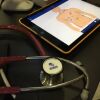Some of the best EMS patient-handling products are also the simplest ones. Here are a few of the hot new patient handling products that make moving patients easier and safer.
Thomas EMS Handles are one good example of excellence in simplicity: Loop straps with molded handles designed to reduce the amount of bending over when lifting.
They do this by adding about 12 inches to the lifting point. This lessens back strain and helps with awkward lifting angles. The handles also reduce abrasions on the hands and knuckles.
The Thomas EMS Handles feature a non-slip handgrip and 1" nylon webbing and work great on scoop stretchers or long spine boards.
EZ LIFT Rescue Systems has a new backboard that takes extended handles to a new level. They are already built-in and hidden inside the backboard. You just pull the retractable end handle free from the board on webbing extension straps.
They provide extra length to lower the pulling stress on your back and transfer the load to your legs and lower body. When you return the lifting handle to the board, the handles retract up inside it.
When you lift a patient on a backboard, you often barely have room to slide your fingers underneath the handgrips. That leaves you bent over with a lot of stress on your lower back. The EZ Lift raises the rescuer’s lifting point to above the knees. It should help to reduce back injuries in EMS.
The manufacturer rates the board to 1,000 lbs. The dimensions are similar to most other boards at 72" by 16" by 2.5", so it can fit in your existing backboard compartment.
Another product, the B.E.A.R., or Bariatric Equalizing Abdominal Restraint, helps make moving obese patients easier.
It is constructed of blue mesh and strong webbing with an innovative closure system that wraps around the patient’s abdomen from the bottom up. It holds a patient’s adipose tissue more in the midline to stabilize a large abdominal mass.
With the abdominal mass stabilized relative to the cot, the cot is more maneuverable and less likely to tip. It works with long backboards and more importantly, with your stretcher.
It offers a few more key benefits. You are more often able to close your cot’s sidebars, and it really helps with making it a more dignified transfer by better protecting patient modesty. Trying to cover an obese patient with a sheet is almost a joke, flying up and causing considerable patient embarrassment. Anything that can enhance patient dignity is a good idea in my book.
I had a chance to talk to Paul Davis, chief of Adams County (Ill.) EMS, about B.E.A.R. He told me the story of an obese patient they transported using it.
He was reported to be heavier than 600 pounds. The B.E.A.R helped the crew move the patient’s mass at least 6 inches, making him narrow enough to close the Stryker Power-Pro’s side rails. He was then able to fit through a standard doorway.
The patient actually thanked the responders after the call, and when his wife called back a week or so later, she asked them to “please bring the big blue wrap.”
It is hard to get a higher compliment on an EMS product than to have patients ask for it. You can read more about this product here.
The Stryker Speed-Sheet is another innovative disposable transfer assist. It makes transfers side-to-side easier and also acts as a protective barrier.
Speed-Sheets are very easy to use and incredibly compact. They look like sealed up yellow garbage bags but are actually a whole lot more.
You activate the Speed-Sheet by tearing one of eight red activating tabs, which breaks the internal vacuum. This converts it instantly into a low-friction transfer device. It’s amazingly easy it is to pull even heavy patients from side to side. The Speed-Sheet makes it almost effortless to move patients from bed to cot and back. It has a lateral load transfer capacity of up to 700 pounds.
The Speed-Sheet measures 72" by 23.5" and comes folded into a tiny 12.5"-by-9" package. You could keep one behind the pillow or just leave it unfolded and tucked under the cot sheet. It would act as a fluid-impervious barrier to help keep the cot mattress clean.
The Hartwell CombiCarrier II makes your life easier by combining all the best features of scoop stretcher and a backboard into one product.
Like a scoop, it can be applied without moving the patient. Like a backboard, it provides a strong, full-body-length supporting structure that still permits a clear AP X-ray view.
The rugged recessed side latch is positioned away from the patient and is easily accessible. It locks instantly during application.
The board also features a concave patient surface for lateral stability and is compatible with most head immobilizers. Hartwell even has a nice head immobilizer specially made for it.
The CombiCarrier II is a highly refined second-generation product. It is built very durable to take the abuse of daily street use. It’s also a proven design from a respected manufacturer who really understands the rigors of EMS. The seamless construction and versatile design should make it very popular.
Most of these great patient handling products are really very simple, and that is one reason they are so effective. Basic, rugged EMS products are usually the ones that can really help EMTs and paramedics do a better job under difficult conditions.












